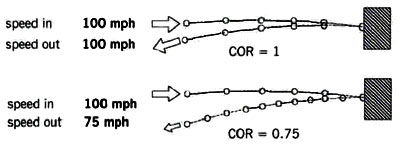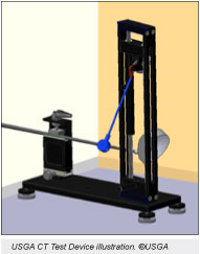coefficient of restitution (.830) or C.O.R.
characteristic time (257 u.s.)
Spring Effect

COR Stands for
Coefficient-of-Restitution
Coefficient of restitution is a measurement of the energy loss or retention when two objects collide. The coefficient of restitution measurement is always expressed as a number between 0.000 (meaning all energy is lost in the collision) and 1.000 (which means a perfect, elastic collision in which all energy is transferred from one object to the other).
It is impossible for the collision of your driver head and your golf ball to produce a perfectly elastic collision (COR of 1.000) in which all energy is transferred, for two reasons:
1.The clubface and the ball are made from completely different materials.
2. The clubhead and the ball are of two totally different weights, or masses.
It has been found that the COR of the collision between lets say a stainless steel driver head, which does not have any Spring Like Effect (SLE) and a standard ball is about 0.78.

USGA RULE
In 1998 The USGA set the COR limit for woods (metal woods) at 0.822 with a test tolerance of .008 effectively taking the limit up to 0.830.
The current USGA rule limiting the coefficient of restitution of a clubhead states that the COR cannot be higher than a measurement of 0.830. This means that when the clubhead impacts the ball, there cannot be more than an 83-percent transfer of the energy of the head to the ball.
To relate this to your golf game-Comparing when you were playing those stainless steel drivers back some years ago and now the new titanium spring-faced drivers, you have gained 21 yards of distance- assuming a driver swing speed of 100 m.p.h. For every increase in C.O.R you gain 4.2 yards.
It is true that as swing speed increases, the distance difference is greater. And likewise, as swing speed decreases the distance difference for each increment of the COR measurement is less. This is one of the reasons why the USGA rule which limits the COR of a clubhead has the effect of penalizing the slower swing speed golfer much more than the high swing speed player.
U.S.G.A. Characteristic Time-New Test

The method of measuring the SPRING LIKE EFFECT in a clubface, recently developed by the USGA is to use a pendulum on the end of which is a metal hemisphere which bounces against the clubface and the contact time relates directly to the SLE. The results of the conformance tests are used in determining conformity of the club head to the Rules of Golf,
Using the pendulum testing apparatus, a golf clubhead is impacted several times by a small steel pendulum. A characteristic time between the clubhead and pendulum is recorded for each impact. The characteristic time is directly related to the flexibility of the golf clubhead
The characteristic time of the clubhead shall not be greater than 239 µs. A maximum test tolerance of 18 µs is associated with this test. Therefore a maximum characteristic time of 257 us. or units, is allowed.
This test measures the response of a shafted golf club. If there is no shaft in the clubhead, one must be temporarily installed prior to testing.
The normal procedure calls for the measurement to be made at the face center, and is meant to replace the old coefficient of restitution method.